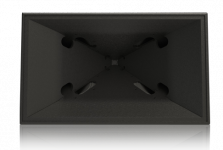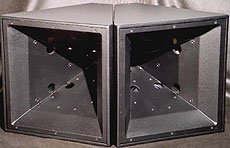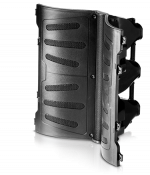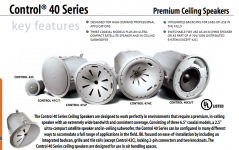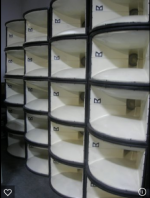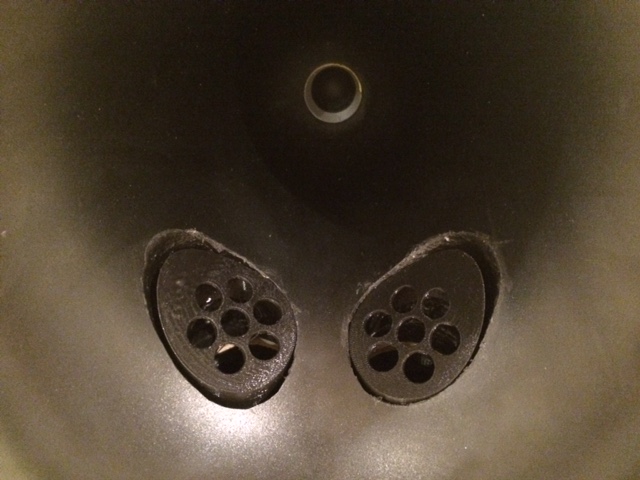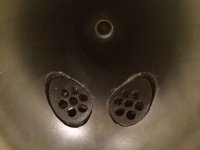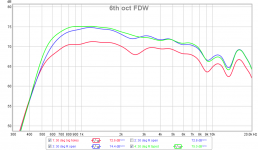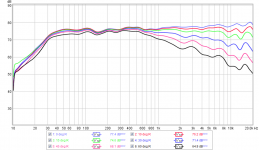xrk971,Art,
I think what you are describing about the LTH142 is consistent with its beamwidth map. It is after all, a tractrix. The 50 deg (25 deg half angle) specification if you go with the yellow contour where it is -5dB in the Vertical orientaion appears to be good for 3k and up, below which it widens.
Factory beamwidth map for LTH142:
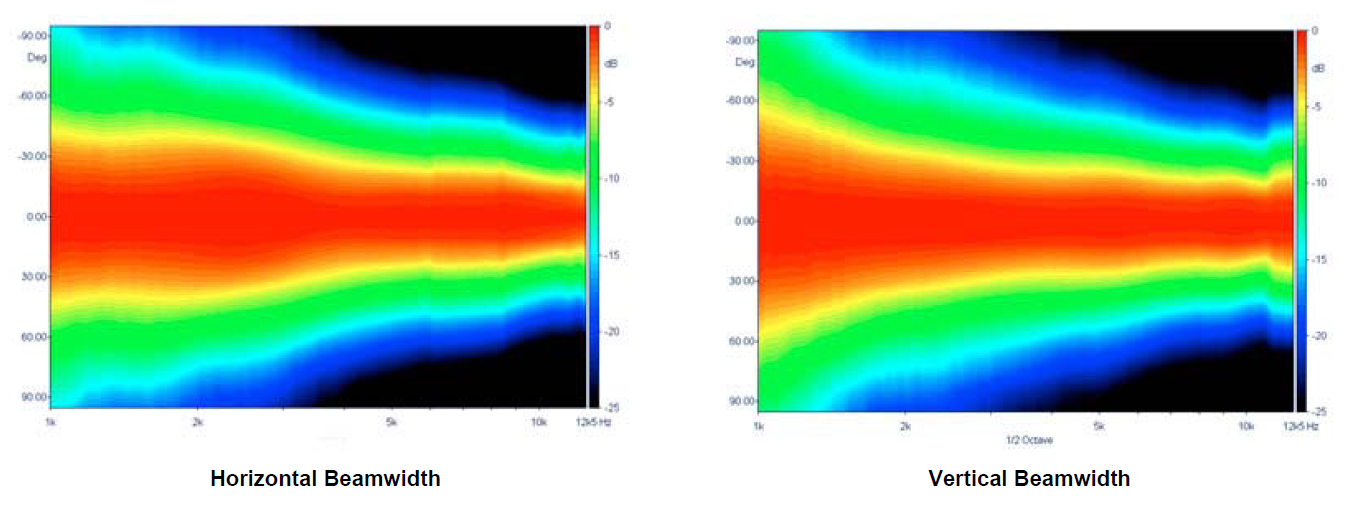
Yes, consistent with tractrix (or similar) contours, the directivity increases with frequency, (less so above 3kHz, where it approximates the nominal pattern designation) and it appears that the upper beamwidth using the inherently "beamy" SB65 also is a bit reduced in comparison to the compression driver used for the spec sheet polar map.
I primarily used beaming horns for almost half my audio career, but after starting to use constant directivity horns, it is hard to go back to the "different in every seat" response of beaming horns.
That said, if you can sit in the center, (or where you have decided to EQ the response for) beaming presents no real problems.
Art
"Pattern control" is generally accepted to be the angle where the nominal dispersion of a horn is -6 dB.
In the case of the SB65 loaded 60 x 50 horn xrk971 is working with presently, in the 50 degree orientation, it is "loosing control" below 2000 Hz, and the pattern has expanded to over 120 degrees at 900 Hz, while contracting to about 30 degrees at 10kHz.
The collapsing pattern the horn exhibits is known as "beaming", similar to the piston response expected of a cone loudspeaker of a similar diameter.
Some people seem to like beaming speakers, others prefer constant directivity.
Constant directivity requires a larger horn dimension in the narrower dispersion direction.
A simple formula to roughly figure pattern control is 1,000,000/Horn angle x horn mouth width (in inches).
For a 15" wide horn with a nominal 60 degree pattern, that works out to 1111 Hz pattern control. For a 10" tall horn with a nominal 50 degree pattern, 2000 Hz.
Horns with secondary horn expansions, or large roundovers at the mouth are actually "smaller" than the mouth dimension in terms of lower pattern control.
P.S. , my previous post regarding the change in the horn's response was incorrect, as xrk971 pointed out, the scale on the chart for the horn with woofer holes was 5dB rather than 10dB, the additional beaming was only 2.5 dB at 9kHz.
Art
That was a typo on my part........should have read 1600hz where i was considering the usual 90 degree 'in home use' pattern........still not bad for mid field use at home which is i believe what a compact Synergy might be designed for?
DSL's Synergy horns are designed for constant directivity using conical expansion horns. A horn that does not have constant directivity (regardless of coverage angle) does not adhere to one of the fundamental Synergy concepts.That was a typo on my part........should have read 1600hz where i was considering the usual 90 degree 'in home use' pattern........still not bad for mid field use at home which is i believe what a compact Synergy might be designed for?
90 degree coverage can maintain constant directivity almost an octave lower than a 50 degree coverage horn of the same "compact" mouth dimensions, but at a reduction in sensitivity.
Art
Are the rounded fiberglass Unity horns constant directivity also? Is it the mid injection ports near the compression driver throat that makes it a synergy? Don't other manufacturers have bass injection ports towards the mouth end of the horn? I think JBL has the VERTEC technology. Most are V horns for line arrays though.
VTX 25 for example.
VTX 25 for example.
Last edited:
Are the rounded fiberglass Unity horns constant directivity also? Is it the mid injection ports near the compression driver throat that makes it a synergy? Don't other manufacturers have bass injection ports towards the mouth end of the horn? I think JBL has the VERTEC technology. Most are V horns for line arrays though.
VTX 25 for example.
JBL VTX pro series have separate cabinets for low and mids and another cab forming a unity horn for mid/higs. I see their concept is a 3 way "standard" design but with adding horn.
The only I know with "similar" (not to much) concept is a design from Thomas Danley (I think he are in your country) and it was a novelty with very good reviews few years ago. He's horn unity / sinergy with 2 ways that can be seen in the link attached.
SH95 | Danley Sounds Labs | Danley Sound Labs, Inc.
All horns designs unity / synergy (at least that I know or have heard) has its bandpass holes drivers for mid / low at the entrance to the neck of the horn or so close the CD. I never saw a design that has the holes in the walls or so much closer to the mouth.
But again you can see he is using a 1" CD and a unity/sinergy typical design.
This is probably because the designers maninly try to keep intact all the radiant characteristics of the horn.
I see here that build have a so promissing re-think about all that and the observed results from your data shows are on rigth track to really improve much things with a building that people will speak much much time because his inovation and mainly his achieved performance and quality at highest level.
A near field monitor with FR driver and unity/synergy build ? 😱 ... yeah a real inovattion.
Time will give us all the answers...will see
Last edited:
A 3 way Danley SH 96 as example


I think I see midrange ports close to the horn entrance, (slot) woofer holes further out and ported holes even further out towards the mouth.
You can see the horns with a smaller coverage are shaped to work in multiples side by side:

Pretty clever product range to get a wider coverage if needed. Like Art does with the Maltese horns.
But that probably wasn't the point Art was trying to make. Horn shape determining the directivity of the entire response.
You would want that constant directivity to cover the crowd. How much of that is important in our home can be up for debate.
Some like or prefer the JMLC horn shape that isn't a constant directivity horn, etc...
I think I see midrange ports close to the horn entrance, (slot) woofer holes further out and ported holes even further out towards the mouth.
You can see the horns with a smaller coverage are shaped to work in multiples side by side:
Pretty clever product range to get a wider coverage if needed. Like Art does with the Maltese horns.
But that probably wasn't the point Art was trying to make. Horn shape determining the directivity of the entire response.
You would want that constant directivity to cover the crowd. How much of that is important in our home can be up for debate.
Some like or prefer the JMLC horn shape that isn't a constant directivity horn, etc...
Attachments
Last edited:
The JBL VTX uses what they all a Radiation Boundary Integrator (RBI) which has 6 mid/bass drivers (6in I think) mounted on the walls of a V-horn. Three D2 dual diaphragm coaxial compression drivers feed waveguides leading to the vertex of the V horn. The 6 mid bass drivers here also volume plugs on the cone side with 3 band pass slots per driver. This is what I was saying is similar in the concept of bass injection on the horn wall towards the periphery near the mouth. Although the VTX uses longitudinally disposed slots rather than round holes.
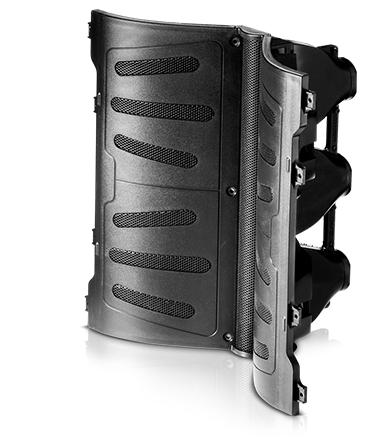

Attachments
The JBL isn't a point source while Tom's products are usually designed to be just that.
I've seen V shaped array modules with bare visible drivers left and right and other variants.
What you guys doing here is still a synergy or unity type of horn. Even without the mid ports close to the entrance of the horn. Just another variant of it. But it isn't constant directivity like the Danley horns when you use a different horn profile from the start.
The big question: what is the ideal directivity needed in a home. That should determine the horn shape.
To add to this, how low do you want to keep that directivity, that should determine horn size.
Unless you get clever with cardoid like enclosures for the woofers 🙂.
I've seen V shaped array modules with bare visible drivers left and right and other variants.
What you guys doing here is still a synergy or unity type of horn. Even without the mid ports close to the entrance of the horn. Just another variant of it. But it isn't constant directivity like the Danley horns when you use a different horn profile from the start.
The big question: what is the ideal directivity needed in a home. That should determine the horn shape.
To add to this, how low do you want to keep that directivity, that should determine horn size.
Unless you get clever with cardoid like enclosures for the woofers 🙂.
Last edited:
There's lots of factors to consider.........room dimensions in relation to the listening position(s) is an important place to start. Take my home theater which is 13 x18 feet. Given the speaker distance three feet from the rear wall and each LR two feet from the side wall, the average 90 degree horizontal coverage horn doesn't cut it for me so I went to 60 degrees which made a marked improvement in upper mid, low treble clarity.
But many people enjoy the reverberant room for music.....it's what they're accustomed to for decades. One just needs to look at the countless speaker designs of conventional drivers mounted on flat baffles with typical radiation patterns of mixed DI and/or uneven power response. There's simply no accounting for subjectivity in this thing other than to say that MANY simply DO NOT know what constant directivity is and the advantages because they've never experienced it OR they have, but didn't know why it sounds the way it does.
Yet none of this accounts for the perception of soundstage or lack there of as this is a purely subjective variable and changes from one recording to the next without any point of reference........and that's not going to change.
There's still A LOT of unknowns in audio and how it relates to our perceptions and psychoachoustics in how it applies to complex music. Add in the fact that the room itself is basically an undefineable variable and the 'optimal' speaker becomes more and more an unobtainable goal for commercial speakers...........
But the DIY crowd is unconstrained in many of the above in that we can design our systems with fewer variables IF we're smart enough to understand the concepts of directivity and power response and how they relate to our listening rooms.........which really only leaves the variables of subjectivity which in my opinion take years of experience to define.
Is a true synergy system a practical approach for home audio?..............I'd have to say no just based on what it's goals are vs what our rooms look like. Reducing the size to fit in the average listening space defies the concept really and IMO you're left with a significant compromise......one that could be equally or better served with an alternative approach
But that doesn't take the fun out of it......the excitement of discovery. It's what drives many of these threads here and other forums. It's what we come here for. The more practical the speaker, the less interesting it is.
I believe our biggest challenge which remains is the nearfield desktop system. As our lives become more and more complex with less time to sit in a non working environment and simply listen, were saddled with multi tasking in our leasure at our desks or workstations listening to systems pointed at our heads with near ZERO depth or development of soundstage or strapped to headphones which personally are always my last resort. But another topic for another thread someday.........
But many people enjoy the reverberant room for music.....it's what they're accustomed to for decades. One just needs to look at the countless speaker designs of conventional drivers mounted on flat baffles with typical radiation patterns of mixed DI and/or uneven power response. There's simply no accounting for subjectivity in this thing other than to say that MANY simply DO NOT know what constant directivity is and the advantages because they've never experienced it OR they have, but didn't know why it sounds the way it does.
Yet none of this accounts for the perception of soundstage or lack there of as this is a purely subjective variable and changes from one recording to the next without any point of reference........and that's not going to change.
There's still A LOT of unknowns in audio and how it relates to our perceptions and psychoachoustics in how it applies to complex music. Add in the fact that the room itself is basically an undefineable variable and the 'optimal' speaker becomes more and more an unobtainable goal for commercial speakers...........
But the DIY crowd is unconstrained in many of the above in that we can design our systems with fewer variables IF we're smart enough to understand the concepts of directivity and power response and how they relate to our listening rooms.........which really only leaves the variables of subjectivity which in my opinion take years of experience to define.
Is a true synergy system a practical approach for home audio?..............I'd have to say no just based on what it's goals are vs what our rooms look like. Reducing the size to fit in the average listening space defies the concept really and IMO you're left with a significant compromise......one that could be equally or better served with an alternative approach
But that doesn't take the fun out of it......the excitement of discovery. It's what drives many of these threads here and other forums. It's what we come here for. The more practical the speaker, the less interesting it is.
I believe our biggest challenge which remains is the nearfield desktop system. As our lives become more and more complex with less time to sit in a non working environment and simply listen, were saddled with multi tasking in our leasure at our desks or workstations listening to systems pointed at our heads with near ZERO depth or development of soundstage or strapped to headphones which personally are always my last resort. But another topic for another thread someday.........
Is tuning flat for 20 degrees off axis, and angling 20 off axis at listening position part of the design criterion?
Toed in speakers is part of the controlled directivity paradigm. It helps widen the sweet spot. You may be closer to one speaker of the LR pair but you are closer to on axis to the other, which tends to equalize the SPL you hear from each.
Then EQing for flat at 20 degrees off axis ends up being a good compromise across the width of a couch, for example. In addition, axi-symmetric horns can have an on axis DIP, which is avoided by listening off axis.
Then EQing for flat at 20 degrees off axis ends up being a good compromise across the width of a couch, for example. In addition, axi-symmetric horns can have an on axis DIP, which is avoided by listening off axis.
1) The Yorkville fiberglass Unity horns are constant directivity, using a conical expansion rounding into the secondary flare.1)Are the rounded fiberglass Unity horns constant directivity also?
2)Is it the mid injection ports near the compression driver throat that makes it a synergy?
3)Don't other manufacturers have bass injection ports towards the mouth end of the horn?
4)I think JBL has the VERTEC technology. Most are V horns for line arrays though.
2) "Unity" was Tom Danley's name for multiple entry horns while with Sound Physics, "Synergy" his name for multiple entry horns while with Danley Sound Labs. Both lines of product have the high frequency at the horn throat, and mid and low frequency drivers exiting through offset horn band pass ports placed as close as practical to the throat to create a virtual single source point within 1/4 wavelength of each bandpass. Since the high frequency leads the bandpass outputs in time, their being closer to the horn mouth physically helps with time alignment, so their passive crossovers can be designed to result in near plat phase response.
3)Since the Vdosc line arrays of 1992 there have been a variety of arrangements used by different manufacturers which are variations of the basic scheme of not disrupting the waveguide too much, and keeping the center to center distance of the mid outputs close together. There are many that have failed to keep the c to c distance close enough (like the original Vdosc ;^) ), which results in off axis dips in response.
4) JBL also has the Control 40 series, using co-axial speakers with band pass ports radially oriented around the HF driver horn entrance.
Art
Attachments
Interesting to see how many designs use bass band pass injection on horn wall.
Working on fitting the port hole repair covers with 7 holes. The other driver I will just drill seven smaller holes and skip the hole saw.
Working on fitting the port hole repair covers with 7 holes. The other driver I will just drill seven smaller holes and skip the hole saw.
Interesting to see how many designs use bass band pass injection on horn wall.
Working on fitting the port hole repair covers with 7 holes. The other driver I will just drill seven smaller holes and skip the hole saw.
With multiple holes it get a resistance working, loading the woofer, maybe it do work very nice.
Good to see so much attemps to get to perfection. (what never happens because of nature laws and mister Murphy).
Martin introduced the concept back in 1978 with the "Philishave" offset 2x12" driver radial low mid horn, though the 12" entrance was large enough that it would not quite be considered a band pass. There have been a lotof variations on the theme since, sharing the horn with additional HF drivers.Interesting to see how many designs use bass band pass injection on horn wall.
Working on fitting the port hole repair covers with 7 holes. The other driver I will just drill seven smaller holes and skip the hole saw.
It will be interesting to see the before and after horizontal and vertical polars after completion- remember to short the mid drivers (unless powered) out when conducting tests to avoid them acting as "tuned traps".
Attachments
The Martin MH-212 "Philishave" (with the grill on it looks like a Philips electric shaver) cabinet height is 18.25", 36" wide. You may have thought you are seeing the entire 12" cone in the picture, but only a portion of the house left cone is visible to the left of the "V" divider between the two throats.I don't see the band pass holes in the above photo.
As I mentioned, "the 12" entrance was large enough that it would not quite be considered a band pass", a 12" speaker behind an approximately 4.5" diameter entrance will band pass the response somewhat, as will the coupling between the two drivers and the horn throat, and the offset angle.
I stated the wrong date of introduction, it was 1976. First heard of them when Supertramp was touring the USA with a Martin/Midas system in '78.
The introduction of a dedicated low mid horn that was capable of clean, controlled directivity output to 1500 Hz was a radical departure from the norm back then of crossing HF compression drivers at 500-800 Hz, a 2-3 octave difference. The reduction in mid distortion was instantly apparent.
Art
Last edited:
Band pass injection hole repair success
I ended up using hot melt glue to fill the gaps and bond the insert to the horn. I was also able to shape the hot glue as it cooled to a pretty smooth profile. I then put a layer of black electrical tape over the glue for the joint temporarily for smooth transition.
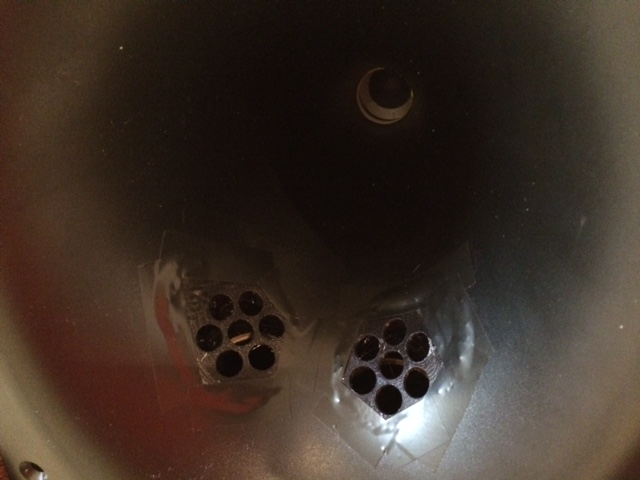
Measurements show that it was quite successful in boosting the output by about +2.5dB and smoothing it out - compared to taping over the holes to simulate a pristine horn.
I concentrated on the 30 deg measurement in detail to see this effect (red=big holes, blue=repaired, green=holes taped over):
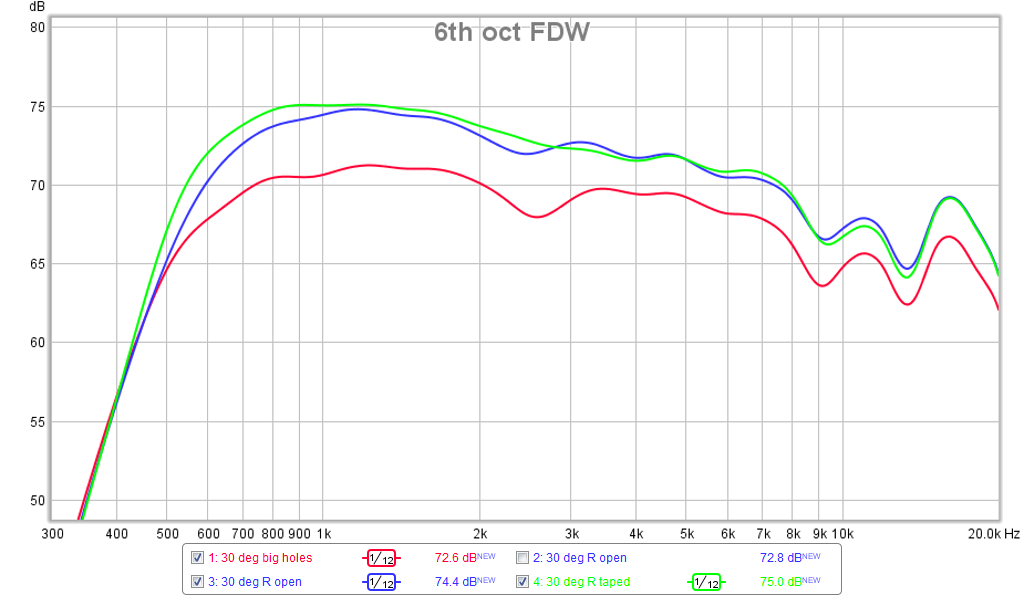
There is still a mild dip at 2.5kHz but the overall shape follows the pristine horn pretty well that I am satisfied with this performance. The taped over holes also has a bit more bass extension.
And here are polars with woofer running :
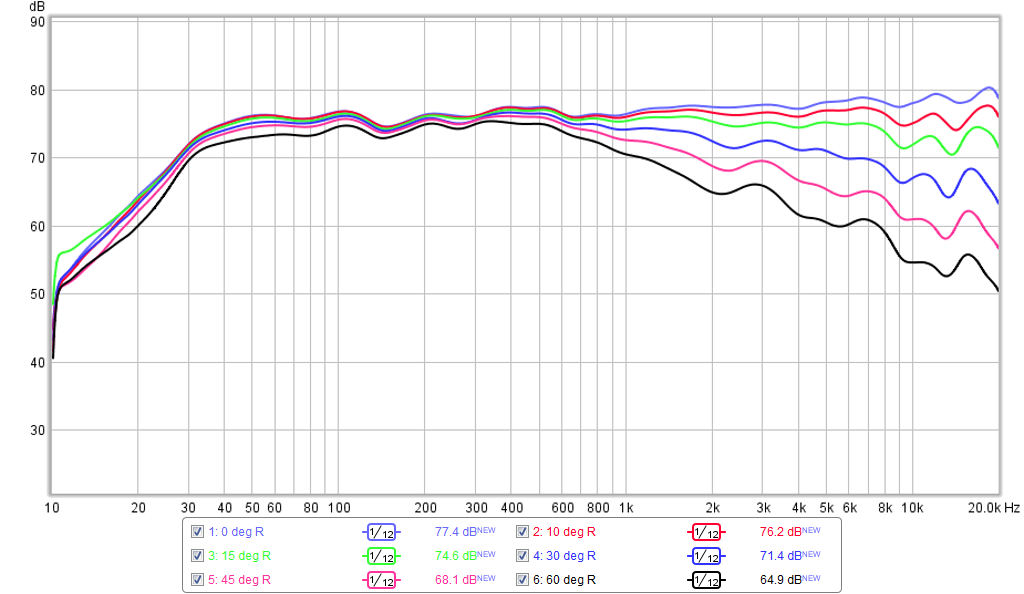
I ended up using hot melt glue to fill the gaps and bond the insert to the horn. I was also able to shape the hot glue as it cooled to a pretty smooth profile. I then put a layer of black electrical tape over the glue for the joint temporarily for smooth transition.

Measurements show that it was quite successful in boosting the output by about +2.5dB and smoothing it out - compared to taping over the holes to simulate a pristine horn.
I concentrated on the 30 deg measurement in detail to see this effect (red=big holes, blue=repaired, green=holes taped over):

There is still a mild dip at 2.5kHz but the overall shape follows the pristine horn pretty well that I am satisfied with this performance. The taped over holes also has a bit more bass extension.
And here are polars with woofer running :

Attachments
Last edited:
- Home
- Loudspeakers
- Multi-Way
- A Bookshelf Multi-Way Point-Source Horn

